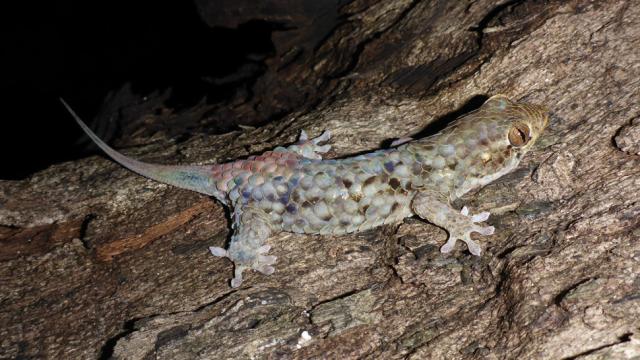Many lizards are capable of detaching their tails when a predator strikes, but one group of geckos has evolved a particularly gruesome escape strategy: Unusually large scales that tear off when a predator tries to take hold, allowing the tiny animals to break free.
The newly described fish-scale gecko, Geckolepis megalepis. (Image: F. Glaw)
As described in the latest edition of Peer J, this new species (Geckolepis megalepis) has the largest scales of any known gecko, both in relative and absolute terms. The abnormally big scales tear off exceptionally easy, providing the animals with an effective anti-predator defence mechanism.
Other geckos have been observed to shed some skin in order to escape, but only if they’re grasped very firmly. These guys do it actively, and at the slightest touch. In other lizards, the scale regeneration process takes a long time, but the fish-scale geckos can grow their armour back in a few weeks, and without any residual scars.

Not surprisingly, the scales and the gecko skin are very well adapted to the tearing action. They’re fixed to the gecko’s skin along a very narrow strip, and a pre-formed “splitting zone” exists on an outer layer of the skin itself. When the scales come off, a layer of skin comes off, too.
The researchers, led by Mark D. Scherz from the Ludwig Maximilian University of Munich and The Zoological State Collection Munich, hypothesise that large scales tear more easily than small scales owing to the increased surface area relative to the attachment area, and because the large scales provide more surface friction.
“What’s really remarkable though is that these scales — which are really dense and may even be bony, and must be quite energetically costly to produce — and the skin beneath them tear away with such ease, and can be regenerated quickly and without a scar,” noted Scherz in a press release.
Scientists have known about fish-scale geckos since the 1860s, but these animals have been notoriously hard to study. These geckos are nocturnal animals, feeding on insects deep in Madagascar’s forest growth. Decades ago, scientists used bundles of cotton wool in an effort to catch the geckos with their scales still firmly attached. Today, scientists lure them into plastic bags. For the latest study, the researchers captured several specimens in their native habitats.
“A study a few years ago showed that our understanding of the diversity of fish-scale geckos was totally inadequate,” said Scherz, “It showed us that there were actually about thirteen highly distinct genetic lineages in this genus, and not just the three or four species we thought existed.”
G. megalepis‘ unusually large scales — even among fish-scale geckos — were a good sign that the researchers were looking at a new species, but they hoped to find more distinguishing characteristics. Because these animals are a nightmare to identify, the researchers turned to micro-CT scanning. The resulting 3D X-ray images allowed the researchers to carefully examine the skeletons without having to dissect them. Looking at the scans, the researchers identified key cranial features that distinguish it from other fish-scale geckos. It’s the first new species of fish-scale geckos to be identified in 75 years.
The regeneration process for the scales is still not very well understood, but further insights could have applications to human medicine. To that end, scientists have taken a look at salamanders and lizards to learn more. Humans wouldn’t grow back scales or tails, of course, but similar biological processes could allow people to regrow and restore function to any part of the body, including the heart, spinal cord and even parts of the brain.
[PeerJ]
